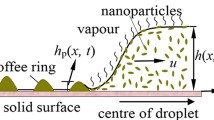Abstract
A kinetic Monte Carlo simulation of nanoparticle film formation via nanocolloid drying is presented. The proposed two-dimensional model addresses the dynamics of nanoparticles in the vertical plane of a drying nanocolloid film. The gas–liquid interface movement due to solvent evaporation was controlled by a time-dependent chemical potential, and the resultant particle dynamics including Brownian diffusion and aggregate growth were calculated. Simulations were performed at various Peclet numbers defined based on the rate ratio of solvent evaporation and nanoparticle diffusion. At high Peclet numbers, nanoparticles accumulated at the top layer of the liquid film and eventually formed a skin layer, causing the formation of a particulate film with a densely packed structure. At low Peclet numbers, enhanced particle diffusion led to significant particle aggregation in the bulk colloid, and the resulting film structure became highly porous. The simulated results showed some typical characteristics of a drying nanocolloid that had been reported experimentally. Finally, the potential of the model as well as the remaining challenges are discussed.









Similar content being viewed by others
References
Abedini A, Bakar AAA, Larki F, Menon PS, Islam MS, Shaari S (2016) Recent advances in shape-controlled synthesis of noble metal nanoparticles by radiolysis route. Nanoscale Res Lett 11:287
Cardinal CM, Jung YD, Ahn KH, Francis LF (2010) Drying regime maps for particulate coatings. AICHE J 56:2769–2780
Chandler D (1987) Introduction to modern statistical mechanics. Oxford Univ Press, New York
Crivoi A, Duan F (2012) Evaporation-induced formation of fractal-like structures from nanofluids. Phys Chem Chem Phys 14:1449–1454
Crivoi A, Duan F (2013a) Elimination of the coffee-ring effect by promoting particle adsorption and log-range interaction. Langmuir 29:12067–12074
Crivoi A, Duan F (2013b) Effect of surfactant on the drying patterns of graphite nanofluid droplets. J Phys Chem B 117:5932–5938
Devendiran DK, Amirtham VA (2016) A review on preparation, characterization, properties and applications of nanofluids. Renew Sust Energ Rev 60:21–40
Gromer A, Nassar M, Thalmann F, Hebraud P, Holl Y (2015) Simulation of latex film formation using a cell model in real space: vertical drying. Langmuir 31:10983–10994
Han W, Li B, Lin Z (2013) Drying-mediated assembly of colloidal nanoparticles into large-scale microchannels. ACS Nano 7:6079–6085
Kabi P, Basu S, Sanyal A, Chaudhuri S (2015) Precision stacking of nanoparticle laden sessile droplets to control solute deposit morphology. Appl Phys Lett 106063101
Kameya Y, Hanamura K (2011) Enhancement of solar radiation absorption using nanoparticle suspension. Sol Energy 85:299–307
Kameya Y, Yamaki H, Ono R, Motosuke M (2016) Fabirication of micropillar TiO2 photocatalyst arrays using nanoparticle-microprinting method. Mater Lett 175:262–265
Kim S, Lee K-S, Zachariah MR, Lee D (2010) Three-dimensional off-lattice Monte Carlo simulations on a direct relation between experimental process parameters and fractal dimension of colloidal aggregates. J Colloid Interface Sci 344:353–361
Martin CP, Blunt MO, Moriarty P (2004) Nanoparticle networks on silicon: self-organized or disorganized? Nano Lett 4:2389–2392
Martin CP, Blunt MO, Pauliac-Vaujour E, Stannard A, Moriarty P (2007) Controlling pattern formation in nanoparticle assemblies via directed solvent dewetting. Phys Rev Lett 99:116103-1–4
Meakin P (1999) A historical introduction to computer models for fractal aggregates. J Sol-Gel Sci Tech 15:971–977
Pauliac-Vaujour E, Stannard A, Martin CP, Blunt MO, Notingher I, Moriarty P (2008) Fingering instabilities in dewetting nanofluids. Phys Rev Lett 100:176102-1–4
Rabani E, Reichman DR, Geissler PL, Brus LE (2003) Drying-mediated self-assembly of nanoparticles. Nature 426:271–274
Routh AF (2013) Drying of thin colloidal films. Rep Prog Phys 76:046603
Siemann U (2005) Solvent cast technology—a versatile tool for thin film production. Progr Colloid Polym Sci 130:1–14
Sun J, Velamakanni BV, Gerberich WW, Rrancis LF (2004) Aqueous latex/ceramic nanoparticle dispersions: colloidal stability and coating properties. J Colloid Interf Sci 280:387–399
Vancea I, Thiele U, Pauliac-Vaujour E, Stannard A, Martin CP, Blunt MO, Moriarty P (2008) Front instabilities in evaporatively dewetting nanofluids. Phys Rev E 78:041601-1–15
Xiong H, Li H, Chen W, Xu J, Wu L (2010) Application of the cluster-cluster aggregation model to an open system. J Colloid Interface Sci 344:37–43
Zhang H, Shan YG, Li L, Lu M, Li R (2016) Modeling the self-assembly of nanoparticles into branched aggregates from a sessile nanofluid droplet. Appl Therm Eng 94:650–656
Acknowledgments
This work was supported by JSPS KAKENHI Grant Number 16K21032 (Grant-in-Aid for Encouragement of Young Scientists (B)).
Author information
Authors and Affiliations
Corresponding author
Ethics declarations
Conflict of interest
The author declares that he has no conflict of interest.
Rights and permissions
About this article
Cite this article
Kameya, Y. Kinetic Monte Carlo simulation of nanoparticle film formation via nanocolloid drying. J Nanopart Res 19, 214 (2017). https://doi.org/10.1007/s11051-017-3898-3
Received:
Accepted:
Published:
DOI: https://doi.org/10.1007/s11051-017-3898-3




